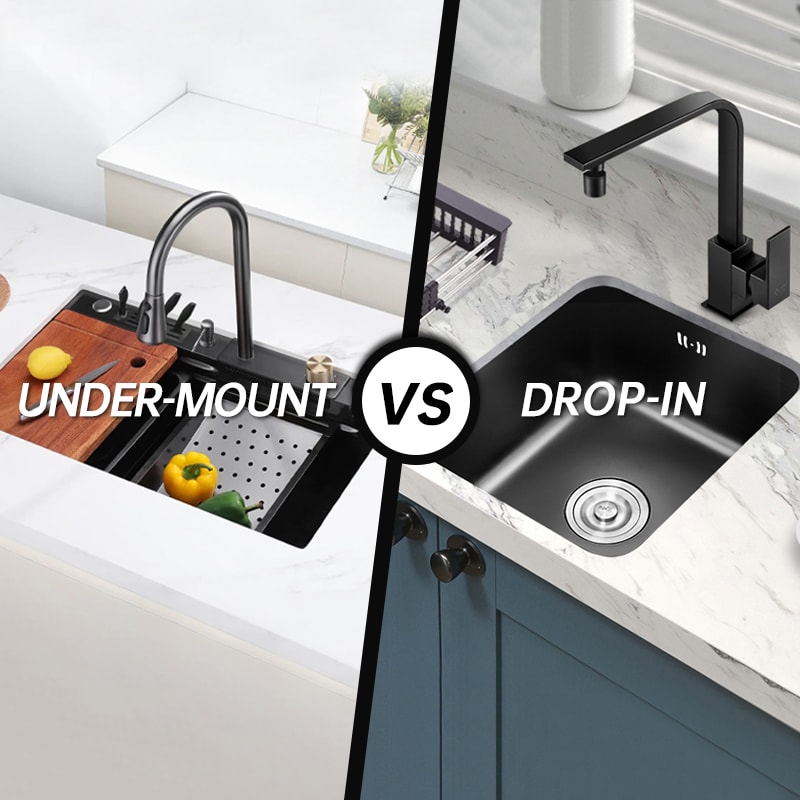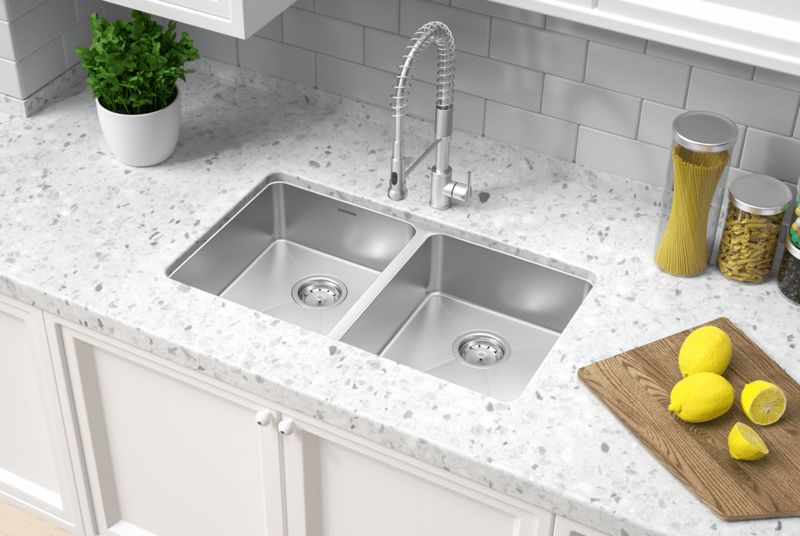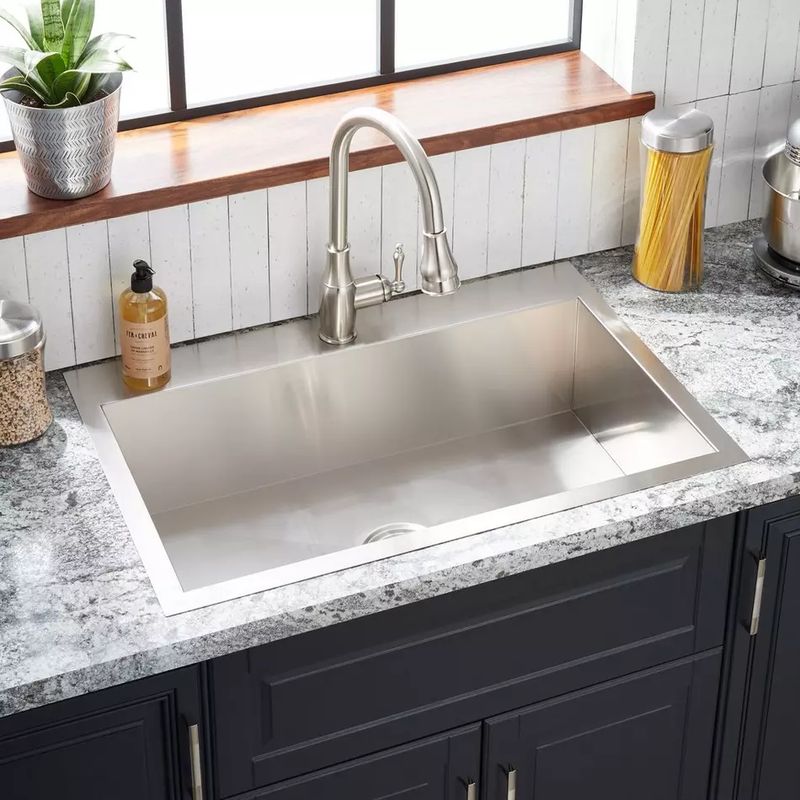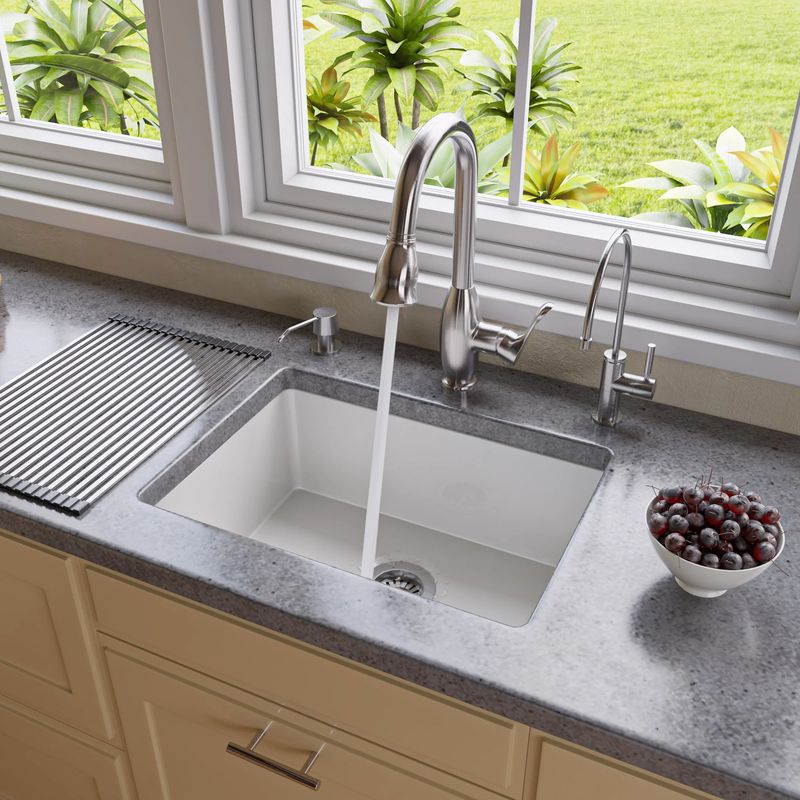 English
English
Jabra Sanitary is a sanitaryware supplier offering toilets, sinks, faucets, bathtubs, etc., at competitive prices. If you're a distributor, wholesaler, or project contractor, get a quote today!
 $23.9 Limited-time Offer
$23.9 Limited-time Offer Consignment Policy
Consignment Policy 20 Years of Experience
20 Years of Experience
When choosing the perfect sink for your kitchen or bathroom, undermount sinks and drop-in sinks are two of the most popular choices. Both offer distinct benefits, but they differ in installation methods, design, maintenance, and cost.
Understanding these differences between undermount and drop in sink is crucial to making an informed decision that suits your needs, lifestyle, and the design of your space.
In this article, we'll compare undermount and drop-in sinks, looking closely at their respective advantages and disadvantages. Besides, we also give you some suggestions on installation and replacement. By the end, you'll have a clear understanding of which option is better for your home.

Table of Contents
Undermount or Drop-in Sinks, Which One is Better?
What is an Undermount Sink
Undermount Sinks: Pros & Cons
Common Under-mount Sink Sizes
What Is a Drop-In Sink
Drop-In Sink: Pros and Cons
Common Drop-in Sink Sizes
The Key Differences Between an Undermount and a Drop-in Sink
Can I Replace a Drop-In Sink With an Undermount?
FAQs
Final Thoughts: Ready to Upgrade Your Kitchen or Bathroom?
Undermount or Drop-in Sinks, Which One is Better?
When choosing between an undermount sink and a drop-in sink from a kitchen sink brand, you need to consider several factors. These include durability, countertop compatibility, style, ease of installation, cleaning, cost, and more.
Here's a simple comparison of the undermount and drop in sink:
| Factors | Undermount Sink | Drop-in Sink |
|---|---|---|
| Material Durability | Made from stainless steel, granite, and porcelain, which resist stains and scratches. | Made from cast iron, stainless steel, and composite, but some are less durable. |
| Countertop Compatibility | Work best with strong countertops like granite, marble, or quartz. | Fit with a variety of countertops, including laminate and wood. |
| Style | Sleek and modern with a smooth and seamless look. | Traditional look with a visible lip on the countertop. |
| Customizations | Fewer design options but available in various shapes and materials. | More customization options in terms of shape, size, and finish. |
| Ease of Installation | Need professional installation for precise fitting. | Easy to install, suitable for DIY projects. |
| Ease of Cleaning & Maintenance | Easy to clean with no lip to trap dirt. | Harder to clean around the lip but still manageable. |
| Space Saving | Save counter space due to the lack of a lip. | Use more counter space because of the visible lip. |
| Cost | More expensive due to the need for professional installation and quality materials. | More affordable with simpler installation and materials. |
| Resale Value | Increase resale value because of its modern and high-end look. | Don't add as much resale value but is still practical. |
In general, which sink type is better will come down to preference. Drop-in sinks are affordable, flexible, and easy to install. But drop-in sinks do not have much in the way of resale value.
Undermount sinks require more of an initial investment but are much more popular, aesthetically pleasing, and have a large deal of resale value.
What is an Undermount Sink
An undermount sink is a sink installed beneath the countertop, with its edge positioned below the countertop surface. This installation creates a smooth and seamless look, making it easier to wipe down the counter and keep the sink out of sight.

Undermount Sinks: Pros & Cons
Like any product, undermount sinks come with their own advantages and disadvantages.
Let's examine the pros and cons to help you decide if this style is right for you:
1. Pros of Undermount Sinks
Sleek and Modern Aesthetic: One of the most attractive features of undermount sinks is their clean and seamless appearance. The lack of a visible lip around the sink creates a sleek and modern look that suits contemporary kitchens and bathrooms.
The smooth transition from the sink to the countertop adds to its minimalistic style.
Easy to Clean: Since undermount sinks are installed below the countertop, there's no lip or rim for dirt and grime to accumulate. This makes cleaning much easier compared to traditional drop-in sinks.
The smooth countertop surface around the sink also makes it simpler to clean and maintain.
Increased Counter Space: With no visible rim or lip protruding from the countertop, undermount sinks don't take up extra space on your counter.
This allows you to maximize your countertop area, providing more room for tasks such as food prep or storage in kitchens, or toiletries and cosmetics in bathrooms.
Enhanced Durability: Undermount sinks are typically made from durable materials like stainless steel, granite, or porcelain, which are resistant to stains, scratches, and heat.
These sinks can last for many years if properly maintained.
Improved Resale Value: Homes with undermount sinks tend to have a higher resale value due to their modern appeal and high-end look.
Buyers often see undermount sinks as a desirable feature in kitchens and bathrooms, which can make your home more attractive on the market.
2. Cons of Undermount Sinks
Higher Installation Costs: Since the installation process requires precise measurements and professional help, it can be more expensive compared to other sink styles.
Additionally, the countertop material must be strong enough to support the sink, which may further increase the cost.
Limited to Certain Counter Materials: Undermount sinks work best with durable countertops such as granite, marble, or quartz.
If you have a less sturdy material, undermount sinks might not be a practical option. This limitation can affect your overall design choices.
Potential for Damage to Countertops: There is a risk that the constant pressure of the sink over time could damage or crack certain countertop materials, especially if they are not installed correctly. Proper installation is critical to prevent such issues.
Difficult Repairs: If your undermount sink becomes damaged or starts to leak, repairing it can be more complicated. Undermount sinks often require removing the sink and re-sealing it, which can be costly and time-consuming.
Common Under-mount Sink Sizes
Undermount sinks come in various sizes to suit different kitchen and bathroom layouts.
The most common sizes for kitchen sinks range from 22 to 33 inches in width, with 5-9 inches being the typical depth for a standard single-basin sink.
Double-basin sinks typically have a width of 22 inches. In bathrooms, under-mount sinks usually measure between 16 to 20 inches in width, with 12 to 18 inches in depth.
It's important to choose the right size based on your countertop space and usage needs to ensure functionality and aesthetic appeal.
What Is a Drop-In Sink
A drop-in sink is a sink installed by placing it into an opening on the countertop. The countertop is slightly larger than the sink.
The sink's rim rests on the surface of the counter. It creates a lip that separates the sink from the countertop.

Drop-In Sink: Pros and Cons
This type of installation offers several advantages but also comes with a few drawbacks.
Let's explore the pros and cons of drop-in sinks to help you make an informed decision:
1. Pros of Drop-In Sinks
Easier Installation: One of the main advantages of a drop-in sink is its simple installation process. Drop-in sinks are easier to install, making them a more cost-effective option for DIYers or those on a budget.
Wide Range of Options: Drop-in sinks are available in a variety of materials, including stainless steel, porcelain, granite composite, and cast iron.
This gives homeowners more flexibility when choosing a sink that fits their aesthetic and functional needs. The variety of sizes, shapes, and colors also makes it easy to find a sink that complements your countertop and overall design.
Durability: Drop-in sinks are typically very durable and resistant to wear and tear. Since the rim of the sink rests on the countertop, it can provide extra protection against accidental impacts. This makes them a good option for high-traffic areas, like kitchens.
Cost-Effective: The materials are often less expensive. The installation process doesn't require as much labor, which makes them an excellent option for those on a budget.
2. Cons of Drop-In Sinks
Harder to Clean: The visible lip or rim of the drop in sink can trap dirt and grime, making it more difficult to clean the area around the sink.
Water, soap, and debris can accumulate in the crevice between the sink and the countertop.
Less Aesthetic Appeal: While functional, drop-in sinks may not offer the sleek and modern appearance.
The visible lip can be a distraction and may not provide a seamless look, especially in contemporary or minimalist designs.
Reduced Counter Space: The rim of a drop-in sink takes up space on the countertop, which can slightly reduce your usable workspace.
While this may not be a major issue in smaller bathrooms, it can be more noticeable in kitchens with limited counter space.
Potential for Damage to Countertops: Over time, the rim of a drop-in sink can cause wear on the countertop surface.
If the sink is not sealed properly, water can seep under the lip, potentially leading to damage or staining of the countertop.
Common Drop-in Sink Sizes
Drop-in sinks are available in a wide variety of sizes to suit diverse kitchen and bathroom needs.
In kitchens, the most common size is 22 inches in width, with depths typically measuring around 6 to 10 inches. For smaller spaces, compact options start as small as 14 inches wide.
In bathrooms, drop-in sinks often measure between 16 to 24 inches in width, making them ideal for vanities of various sizes. The flexibility in sizes allows homeowners to choose a sink that fits their countertop layout and enhances usability without compromising on style.
The Key Differences Between an Undermount and a Drop-in Sink
Understanding the differences between undermount and drop in sink in material durability, countertop compatibility, style, and other essential considerations will help you make an informed decision for your bathroom or kitchen renovation project. Here is a specific comparison:
Material Durability
Undermount Sinks: Typically made of high-quality materials like stainless steel, granite, porcelain, or composite, undermount sinks are designed to withstand daily wear and tear.
Their smooth and seamless installation under the countertop makes them resistant to chipping. Besides, they often have a more refined and durable finish.
Drop-in Sinks: Drop-in sinks are generally available in similar materials but can be more vulnerable to scratches, dents, or discoloration, especially at the rim.
The drop-in design places more material on the surface, potentially making the sink more prone to wear at the edge.
Countertop Compatibility
Undermount Sinks: Undermount sinks require a solid surface countertop like granite, marble, or quartz, where the sink is mounted beneath the countertop for a sleek look.
They work well with stone, wood, or other solid surfaces. However, they may not be compatible with softer materials like laminate without reinforcement.
Drop-in Sinks: Drop-in sinks are more versatile with countertop compatibility. This is because they can be installed into a variety of materials, including laminate, granite, and solid surfaces.
Their rim rests on top of the countertop, making them easier to install in different countertop types.

Style
Undermount Sinks: Undermount sinks are often preferred for modern, minimalist designs, as their installation allows the countertop to appear continuous and sleek.
This clean look complements contemporary and high-end bathrooms or kitchens.
Drop-in Sinks: With a more traditional design, drop-in sinks feature a visible lip that sits on top of the countertop. While this design is timeless and suits a variety of aesthetics, it may not provide the same seamless and modern look as undermount sinks.
Customizations
Undermount Sinks: While undermount sinks typically come in standard shapes and sizes, they can be custom-fit to match unique countertop designs or specific requirements, especially in high-end renovations.
Drop-in Sinks: Drop-in sinks offer more customization options, including a range of different sizes, shapes, and finishes. The exposed rim also allows for more flexibility in design.
Ease of Installation
Undermount Sinks: The installation of undermount sinks is more complex and requires professional help. It involves mounting the sink beneath the countertop and securing it with strong adhesives or brackets. It is a more time-consuming process.
Drop-in Sinks: Drop-in sinks are much easier to install, making them a popular choice for DIYers. They simply drop into a pre-cut hole in the countertop, with no need for additional support beneath the surface.
Ease of Cleaning & Maintenance
Undermount Sinks: The smooth and seamless design of undermount sinks makes them easier to clean, as there are no visible edges where dirt and grime can accumulate. They are ideal for homeowners looking for a low-maintenance sink.
Drop-in Sinks: Drop-in sinks have a visible rim, which can trap water, soap scum, and grime. This makes cleaning a bit more challenging. However, this issue can be mitigated with regular cleaning and proper maintenance.

Space Saving
Undermount Sinks: Undermount sinks are generally considered more space-saving. It is because the lack of a lip or edge means there is more room on the countertop for other items.
Drop-in Sinks: Drop-in sinks tend to occupy more space on the countertop due to their lip. The lip can make the area feel a little more cluttered, especially in smaller bathrooms or kitchens.
Cost
Undermount Sinks: Undermount sinks are usually more expensive due to their installation complexity and high-quality materials. Professional installation costs add to the overall price.
Drop-in Sinks: Drop-in sinks are typically more affordable both in terms of the product itself and installation, as they require less labor and material for installation.
Resale Value
Undermount Sinks: Due to their sleek and modern appearance, undermount sinks often add more value to a home, particularly in high-end bathrooms and kitchens.
Their seamless design makes them a popular choice for those looking to enhance the overall aesthetic of the space.
Drop-in Sinks: While drop-in sinks are functional and durable, they might not add the same level of perceived value as undermount sinks, especially in premium homes.
However, their cost-effectiveness and ease of installation make them an attractive option for mid-range homes.
Can I Replace a Drop-In Sink With an Undermount?
Replacing a drop in sink with an undermount sink is certainly possible, but it involves several important considerations.
First, the countertop material plays a crucial role. Undermount sinks require a solid surface like granite, quartz, or marble for proper installation.
If you already have a drop in sink with a laminate countertop, the material may need to be replaced or reinforced to accommodate the undermount model. <Learn how to replace kitchen sink faucet>

Additionally, the installation process for undermount sinks is more complex than that of drop-in sinks. Undermount sinks are installed beneath the countertop, which requires precise cutting and securing of the sink.
The process typically involves professional installation, which means extra time and cost. It's also important to ensure the existing countertop can support the weight and dimensions of the new undermount sink.
Lastly, you may need to adjust plumbing connections, as undermount sinks often sit lower than drop-in models.
FAQs
How do I install an undermount sink?
Installing an undermount sink requires careful work. First, choose a solid surface countertop like granite or quartz. The sink is attached underneath the countertop with adhesive or brackets.
The countertop needs to be cut precisely to fit the sink. It's best to hire a professional for proper installation.
How do I install a drop-in sink?
Installing a drop-in sink is easier. Measure and cut a hole in the countertop for the sink's lip. Then, drop the sink into the hole and seal it with silicone. Use clamps to hold it in place.
This type of installation is often DIY-friendly, but make sure everything is aligned to avoid leaks.
Are drop-in sinks out of style?
No, drop-in sinks are not out of style. They're still a great option for traditional and country-style bathrooms, even though undermount sinks are more common in modern designs.
Can undermount sinks fall out?
An undermount sink will not fall out if installed properly. It is securely attached with adhesive and brackets. If installed incorrectly, however, there could be issues. Therefore, professional installation is recommended.
Can I install an undermount sink on any countertop?
Undermount sinks work best with solid surface countertops like granite, quartz, or marble. They may not work well with laminate without extra reinforcement.
Always consult a professional before choosing a countertop material.
Final Thoughts: Ready to Upgrade Your Kitchen or Bathroom?
Choosing between an undermount and a drop-in sink ultimately depends on your style, budget, and functional needs. Whether you go for the clean lines of an undermount or the practicality of a drop-in, both options can elevate your space.
Apart from that, don't remember to consider installation issues and think carefully before you replace a drop in sink with an overmount. All things being considered, are you ready to upgrade your kitchen bathroom?





















